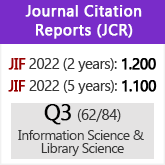Longitudinal analysis of Ecuador’s Library System
DOI:
https://doi.org/10.3989/redc.2016.4.1327Keywords:
Databases, libraries, publishers, current state, universitiesAbstract
The success of the finest universities in the world is based to a large extent on the development of the library system. At the same time these systems are subjected to a competitive dynamic, with the aim of promoting knowledge generation. Ecuador is not exempt from this dynamic and currently finds itself in the midst of an overall development of its higher education system. The present study offers a longitudinal analysis of the current state of the university library system, based on a sample 25 of the 54 existing universities. Under consideration were administrative, technological, economic and service variables, the most important being the number of documents per student and the investment in database access. In addition, the way in which libraries acquire scientific information databases is explored, together with what is currently on offer and the level of government investment for providing database access.
Downloads
References
Álvarez-Muñoz, P; Pérez-Montoro, M. (2015). Análisis de la producción y visibilidad de la producción científica de Ecuador en el contexto andino (2000- 2013). El profesional de la Información, 24(5). https://doi.org/10.3145/epi.2015.sep.07
Babini, D. (2011). Acceso abierto a la producción científica de América Latina y el Caribe: Identification of main institutions for regional integration strategies. Revista Iberoamericana de Ciencia Tecnología y Sociedad, 6(17), 31-56.
CEAACES. (2013). Informe final de evaluación institucional de CEAACES a Universidad Estatal de Milagro. Constitución Ecuador. (2008). Constitución política del Ecuador. Constitución política del Ecuador. Ecuador.
Favero, R; Taruhn, R. (2001). Biblioteca Electrónica de revistas científicas internacionales: proyecto consorcio. Revista cubana de los profesionales de la Información de la Salud, 9(4), 96-100.
IFLA. (1994). IFLA. Sección de Bilbiotecas Públicas. El Manifiesto IFLA/UNESCO en favor de las Bibliotecas Públicas. La Haya. UNESCO.
IFLA/UNESCO. (2001). Directrices IFLA/UNESCO para el desarrollo del servicio de bibliotecas públicas. UNESCO.
LOES. (12 de octubre de 2010). Ley Orgánica de Educación Superior. Registro Oficial 298. 1-40. Ecuador.
Pacheco, F; Álvarez-Mu-oz, P. (2015). Informe de Análisis de Bibliotecas Universitarias Ecuatorianas. Técnico, Universidad Estatal de Milagro.
Puente, L. (2013). Biblioteca pública, democracia y buen vivir; aportes para la definición de políticas en Ecuador. Flacso- Ecuador, 34-86.
Rodas, L.A.; Blasco, J.J. (2014). La evaluación y la acreditación de la educación superior ecuatoriana y la producción editorial. Universitas(21), 163-181. https://doi.org/10.17163/uni.n21.2014.15
SENESCYT. (2015). Informe de inversión en plataformas de recursos científicos. Subsecretaría de Innovación y Transferencia Tecnológica (SENESCYT).
SENPLADES. (2015). SENPLADES, Secretaría Nacional de Planificación y Desarrollo. Recuperado el 12 de 05 de 2015, de SENPLADES, Secretaría Nacional de Planificación y Desarrollo: http://www.planificación.gon.ec/bibliotecas-vituales
SNIESE. (2013). Estudiantes matriculados en el Sistema de Educación Superior Ecuatoriano al 2013. Sistema Nacional de Información de Educación Superior del Ecuador.
Térmens-Gruells, M. (2007). Las revistas electrónicas en las universidades catalanas. Consorcio de Bibliotecas de universidades catalanas, COBUC, 1(3), 104.
Published
How to Cite
Issue
Section
License
Copyright (c) 2016 Consejo Superior de Investigaciones Científicas (CSIC)

This work is licensed under a Creative Commons Attribution 4.0 International License.
© CSIC. Manuscripts published in both the printed and online versions of this Journal are the property of Consejo Superior de Investigaciones Científicas, and quoting this source is a requirement for any partial or full reproduction.All contents of this electronic edition, except where otherwise noted, are distributed under a “Creative Commons Attribution 4.0 International” (CC BY 4.0) License. You may read here the basic information and the legal text of the license. The indication of the CC BY 4.0 License must be expressly stated in this way when necessary.
Self-archiving in repositories, personal webpages or similar, of any version other than the published by the Editor, is not allowed.

















